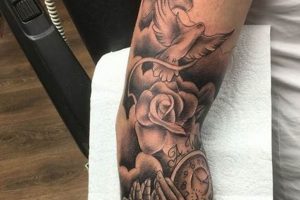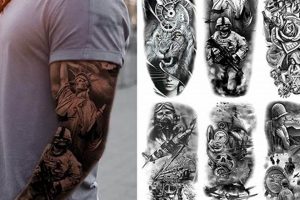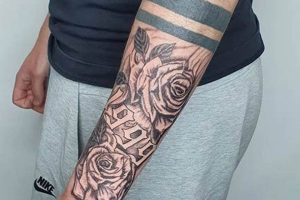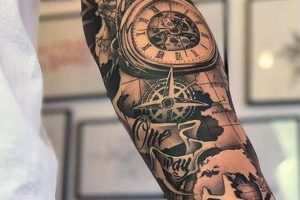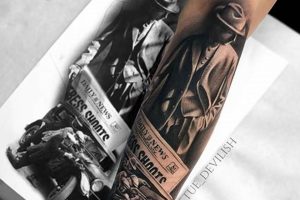Leg sleeve tattoo designs encompass a wide range of artistic expressions, encompassing themes from nature and mythology to abstract patterns and personal narratives. A cohesive visual story, often incorporating multiple elements and styles, unfolds across the entire leg, from ankle to thigh. For instance, a nature-inspired sleeve might feature intertwining flora and fauna, while a geometric design could utilize intricate linework and shapes to create a visually striking piece.
This extensive form of body art offers a large canvas for complex and detailed artwork. It provides an opportunity for significant self-expression, allowing individuals to showcase passions, beliefs, and experiences in a visually compelling manner. Historically, full-leg tattoos held cultural significance in various societies, symbolizing status, spirituality, or lineage. In contemporary tattoo culture, the leg sleeve maintains its appeal as a powerful statement of personal identity and artistic appreciation.
Exploring the myriad options available within this art form can be a rewarding process. Consideration of style, subject matter, artist selection, and the ongoing commitment to aftercare are all essential factors in realizing a successful and personally meaningful leg sleeve tattoo. This discussion will delve further into these important aspects.
Tips for Planning a Leg Sleeve Tattoo
Careful planning is crucial for a successful leg sleeve tattoo. Rushing into the process without considering key elements can lead to dissatisfaction with the final result. These tips offer guidance for a well-considered and ultimately fulfilling experience.
Tip 1: Theme Selection: Choosing a cohesive theme provides a framework for the entire design. This could involve a specific style, such as Japanese traditional or realism, or a narrative theme, like a mythological story or personal journey.
Tip 2: Research Artists: Finding an artist specializing in the desired style is essential. Examining portfolios and seeking recommendations ensures artistic compatibility and high-quality execution.
Tip 3: Budget Considerations: Leg sleeves are significant undertakings, often requiring multiple sessions. Establishing a realistic budget beforehand helps manage expectations and avoids financial strain.
Tip 4: Placement and Flow: The design should flow naturally with the contours of the leg. Discuss placement options with the artist to optimize visual impact and comfort.
Tip 5: Pain Management: Leg tattoos can be painful, particularly in sensitive areas. Preparing mentally and discussing pain management techniques with the artist can make the process more manageable.
Tip 6: Aftercare Commitment: Proper aftercare is essential for healing and preserving the vibrancy of the tattoo. Following the artist’s instructions diligently is crucial for long-term satisfaction.
Tip 7: Flexibility and Collaboration: While a clear vision is important, remaining open to the artist’s expertise and suggestions can enhance the final design. A collaborative approach often yields the best results.
By considering these factors, individuals can embark on the journey toward a leg sleeve tattoo that is not only visually stunning but also a meaningful and enduring piece of personal art.
With these preparatory steps complete, the focus can shift to the exciting process of bringing the vision to life.
1. Theme (nature, mythology)
Thematic coherence is a cornerstone of successful leg sleeve tattoo design. Themes such as nature and mythology provide rich conceptual frameworks, allowing for diverse artistic interpretations and deeply personal narratives. Nature themes can encompass botanical motifs, animal portraits, landscapes, or depictions of celestial bodies. These elements can symbolize growth, resilience, interconnectedness with the natural world, or the cyclical nature of life and death. A sleeve depicting a forest scene, for example, might represent personal growth and the journey of life, while a wave motif could symbolize change and adaptability. Mythological themes, drawing from diverse cultural traditions, offer a vast reservoir of symbolic imagery. Depictions of deities, mythical creatures, or epic narratives can represent values, beliefs, or personal struggles. A Norse mythology-inspired sleeve might feature figures like Odin or Thor, symbolizing strength and wisdom, while a Greek mythology theme could incorporate imagery of Medusa or the Hydra, exploring themes of transformation and resilience.
The choice between nature and mythology, or a combination of both, depends on individual preferences and the intended message. Careful selection of thematic elements allows for a cohesive narrative across the leg, transforming the body into a canvas that tells a compelling story. This approach moves beyond mere decoration and elevates the tattoo to a powerful form of self-expression. A leg sleeve inspired by Japanese mythology might feature a dragon intertwined with cherry blossoms, representing strength and beauty, while a nature-themed sleeve could blend realistic depictions of animals with abstract floral patterns, symbolizing the interconnectedness of life. The choice of specific elements within these broad themes offers endless possibilities for personalization.
Ultimately, thematic resonance strengthens the impact and longevity of a leg sleeve tattoo. It provides a foundation for a meaningful and visually compelling piece of art that resonates with the wearer’s identity and values. By carefully considering thematic elements, individuals can ensure that their leg sleeve tattoo remains a source of personal significance and artistic appreciation for years to come. This intentional approach fosters a deeper connection between the individual and their body art, transforming the tattoo into a powerful symbol of self.
2. Style (realism, traditional)
Style significantly impacts the aesthetic and narrative of leg sleeve tattoos. Realism, with its focus on detailed and lifelike representation, lends itself to portraiture, nature scenes, and depictions of objects with intricate textures. The smooth shading and precise lines characteristic of realism create visually striking pieces often imbued with a sense of depth and dimension. A realistic leg sleeve might feature a portrait of a loved one rendered in meticulous detail, a vibrant depiction of a natural landscape, or a hyperrealistic portrayal of an animal.
Traditional styles, such as Japanese, American, or Polynesian, offer established visual vocabularies with distinct characteristics. Japanese traditional, for example, frequently incorporates bold lines, vibrant colors, and iconic imagery like dragons, koi fish, and cherry blossoms, often interwoven with intricate background details. American traditional, characterized by bold outlines and a limited color palette, frequently features iconic imagery such as anchors, roses, and eagles. Polynesian tattoos, with their intricate geometric patterns and symbolic meanings, represent a rich cultural heritage. Choosing a traditional style often imbues the leg sleeve with established cultural significance and symbolic weight. The specific imagery within the chosen style can further personalize the narrative and add layers of meaning.
Selecting an appropriate style requires careful consideration of the desired theme and overall aesthetic. The chosen style should complement the subject matter and contribute to the intended narrative. The precision of realism can enhance the emotional impact of a portrait, while the bold lines and symbolic imagery of a traditional style can lend weight and cultural significance to a mythological theme. Ultimately, the chosen style significantly contributes to the leg sleeve’s overall impact, transforming it from a collection of images into a cohesive and meaningful work of art. Careful consideration of style ensures a visually compelling and personally resonant piece.
3. Placement (full leg, calf)
Placement is a critical factor in leg sleeve tattoo design, influencing the overall composition, visual flow, and the narrative conveyed. Strategic placement enhances the leg’s natural contours and maximizes the impact of the chosen design elements. Understanding the various placement options and their implications is essential for creating a cohesive and visually appealing leg sleeve.
- Full Leg Coverage
Full leg coverage extends from the ankle to the upper thigh, offering the largest canvas for intricate and complex designs. This placement allows for comprehensive narratives and the incorporation of multiple elements that flow seamlessly together. Full leg sleeves can create a dramatic and impactful statement, showcasing a cohesive artistic vision.
- Calf Sleeve
Calf sleeves focus on the area from the ankle to just below the knee. This placement is suitable for smaller, self-contained designs or as a starting point for a potential full leg sleeve in the future. Calf sleeves offer a balance between visibility and coverage, allowing for a prominent display without the full commitment of a full leg piece.
- Thigh Placement
Thigh placements can be incorporated into a full leg sleeve or stand alone. This area allows for larger designs and can be strategically used to emphasize specific elements of the overall theme. Thigh placements can be easily concealed or revealed, offering versatility in terms of visibility.
- Knee and Ankle Considerations
The knee and ankle present unique challenges due to their curved surfaces and proximity to bone. Designs incorporating these areas require careful consideration of placement and the artist’s skill in adapting the design to these complex contours. Successfully integrating these areas can enhance the overall flow and visual impact of the leg sleeve.
Careful consideration of placement optimizes the visual impact of the leg sleeve, ensuring that the design complements the natural contours of the leg and effectively communicates the intended narrative. The choice between a full leg, calf, or thigh placement, as well as the integration of the knee and ankle, significantly influences the overall aesthetic and storytelling potential of the tattoo. Strategic placement ensures that the leg sleeve not only serves as a visually striking piece of art but also as a cohesive and meaningful expression of personal identity.
4. Color palette (vibrant, monochromatic)
Color palettes profoundly influence the mood, impact, and overall aesthetic of leg sleeve tattoos. A vibrant palette, employing a wide spectrum of colors, can evoke feelings of energy, joy, and exuberance. Such palettes often feature saturated hues and contrasting tones, creating a visually dynamic and eye-catching effect. A leg sleeve depicting a tropical landscape might utilize vibrant greens, blues, and yellows to capture the lushness and vibrancy of the environment, while a design inspired by a festival could incorporate a rainbow of colors to convey a sense of celebration and excitement. The interplay of colors in a vibrant palette adds depth and complexity to the design, creating a visually captivating piece.
Monochromatic palettes, utilizing variations of a single color, offer a different aesthetic experience. These palettes can create a sense of unity, sophistication, and timelessness. A black and grey monochromatic palette, for instance, can evoke a sense of classicism and elegance, often used to emphasize the interplay of light and shadow. This approach can be particularly effective for realistic portraits or designs featuring intricate details. A monochromatic palette focusing on shades of blue could evoke a sense of tranquility and depth, suitable for aquatic themes or abstract patterns. The subtle gradations within a monochromatic palette create a sense of depth and visual interest without the dynamism of a vibrant palette. The choice depends entirely on the desired aesthetic and the narrative being conveyed.
Careful consideration of color palettes is essential for achieving the desired aesthetic and emotional impact. The chosen palette should complement the theme and style of the leg sleeve, enhancing the overall narrative and personal meaning. Whether opting for the vibrancy of a multicolored palette or the understated elegance of a monochromatic scheme, the color choices significantly contribute to the final result. Understanding the psychological and emotional impact of different color palettes empowers individuals to make informed decisions that align with their artistic vision and personal expression. A thoughtfully chosen color palette transforms a leg sleeve tattoo into a cohesive and impactful work of art.
5. Personal elements (portraits, quotes)
Incorporating personal elements like portraits, quotes, or significant dates elevates leg sleeve tattoos from decorative art to deeply meaningful personal narratives. These elements infuse the design with individual significance, transforming the tattoo into a permanent testament to cherished memories, relationships, or guiding principles. A portrait of a loved one can serve as a lasting tribute, while a quote from a favorite literary work or song lyric can encapsulate a personal philosophy. Incorporating birthdates or anniversaries commemorates significant milestones, weaving personal history into the fabric of the design. The inclusion of such elements fosters a profound connection between the individual and the artwork, making the leg sleeve a powerful expression of personal identity.
The selection and integration of personal elements require thoughtful consideration. Portraits demand a skilled artist capable of capturing accurate likenesses and conveying emotion. Quotes should be chosen for their enduring relevance and personal resonance, carefully integrated into the overall design to complement the visual narrative. Dates and other symbolic elements can be incorporated through stylized typography or incorporated into the imagery itself. For example, a portrait of a parent could be combined with their favorite flower, creating a layered tribute that speaks to both their personality and the wearer’s relationship with them. A quote about resilience could be intertwined with imagery of a phoenix rising from ashes, visually reinforcing the message. Skillful integration of these elements ensures that they enhance, rather than detract from, the overall aesthetic of the leg sleeve.
Ultimately, incorporating personal elements imbues leg sleeve tattoos with unique meaning and lasting value. These elements transform the tattoo into a powerful storytelling medium, allowing individuals to express their deepest values, commemorate significant experiences, and celebrate the people and principles that shape their lives. This personalization transforms the leg sleeve from a purely aesthetic choice into a deeply personal and enduring work of art. The careful selection and integration of personal elements are essential for realizing the full potential of the leg sleeve as a form of self-expression and storytelling.
Frequently Asked Questions
Individuals considering leg sleeve tattoos often have questions regarding the process, aftercare, and long-term implications. Addressing these common inquiries provides clarity and empowers informed decision-making.
Question 1: How long does a leg sleeve tattoo typically take to complete?
Completion time varies depending on design complexity, size, individual pain tolerance, and artist availability. A leg sleeve typically requires multiple sessions, ranging from several hours each, spread over weeks or months. Complex designs with intricate details or extensive color work naturally require more time.
Question 2: What factors influence the cost of a leg sleeve tattoo?
Cost depends on factors such as artist experience and reputation, design complexity, size, color usage, and geographic location. Detailed, large-scale designs by renowned artists in major metropolitan areas typically command higher prices. Obtaining a detailed quote requires consultation with the chosen artist.
Question 3: What is the recommended aftercare process for a leg sleeve tattoo?
Proper aftercare is crucial for healing and longevity. Artists provide specific aftercare instructions tailored to individual needs. General guidelines include keeping the tattoo clean, moisturized, and protected from sun exposure. Strict adherence to aftercare instructions minimizes the risk of infection and ensures optimal healing.
Question 4: How painful is getting a leg sleeve tattoo?
Pain levels vary depending on individual pain thresholds and the specific location on the leg. Areas with thinner skin or closer proximity to bone tend to be more sensitive. Discussing pain management strategies with the artist can help alleviate discomfort during the process. Various methods, such as topical anesthetics or breaks during sessions, can improve the experience.
Question 5: Can leg sleeve tattoos be covered up or removed?
Covering a leg sleeve tattoo can be challenging due to its size and complexity. Clothing options provide a practical solution for concealment in professional or formal settings. Laser tattoo removal offers a more permanent solution but requires multiple sessions and may not completely eliminate the tattoo. Discussing cover-up or removal options with a tattoo artist or dermatologist provides personalized guidance.
Question 6: How does a leg sleeve tattoo age over time?
Tattoo longevity depends on several factors, including initial quality, ink type, sun exposure, and individual skin characteristics. Colors may fade slightly over time, and lines may soften. Proper aftercare, minimizing sun exposure, and occasional touch-ups can help maintain vibrancy and clarity over the years. Consulting with a tattoo artist for advice on long-term care ensures the lasting beauty of the artwork.
Careful consideration of these aspects empowers individuals to make informed decisions about leg sleeve tattoos, ensuring a positive and fulfilling experience.
Beyond these frequently asked questions, further exploration of specific design ideas can help solidify artistic vision and guide the collaborative process with a chosen tattoo artist.
Conclusion
Exploration of leg sleeve tattoo design necessitates careful consideration of thematic coherence, stylistic choices, strategic placement, color palette, and the integration of personal elements. These factors contribute significantly to the overall aesthetic, narrative depth, and personal resonance of the final artwork. A well-planned leg sleeve evolves beyond mere decoration, becoming a powerful statement of personal identity, a canvas for storytelling, and a lasting testament to individual values and experiences. Successful execution relies on thorough research, collaboration with a skilled artist, and a commitment to proper aftercare.
Leg sleeve tattoos represent a significant commitment, both artistically and personally. Thorough planning and thoughtful consideration of these elements ensure a rewarding outcomea visually compelling and deeply meaningful piece of art that resonates with the wearer for years to come. The potential for creative expression within this art form is vast, offering a unique opportunity for individuals to transform their bodies into living canvases that reflect their innermost selves.



